Salaat means to pray. This is carried out in steps or units. Each unit is called a Raka’at. There are two, three and four Raka’at Salaat in the Fardh.
Each Raka’at consists of the following essential parts:
- The posture of standing erect is called Qiyaam.
- The posture of genuflection or bowing lowly is called Ruku.
- The posture of prostration or placing the forehead on the ground is called Sajda. Each unit or Raka’at has two Sajdas, i.e. the prostration has to be performed twice in each Raka’at.
- Salaam - to end the intended Raka’at.
Every two Raka’ats are followed by a sitting posture. In other words it is necessary to sit in a kneeling posture after completing two Raka’ats of any Salaat. This kneeling posture is known as Qad’ah.
Two Sajdas (prostrations) are always separated by a kneeling posture. This kneeling posture, which separates one Sajda from the other, is called Jalsah.
Method of Performing a Two-Raka’at Salaat
The Position of Qiyaam
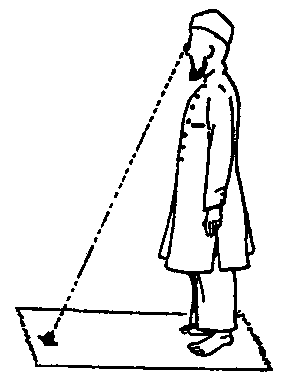
Namazi standing in Salaat should fix his gaze at the place of Sajda
The Namazi stands erect, facing the Qiblah. He makes the Intention for his Salaat and says:
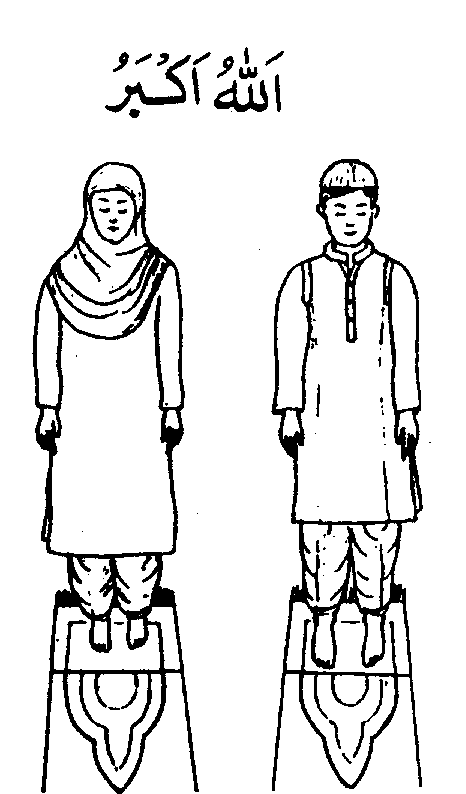
This sketch shows dress and position immediately before starting Salaat
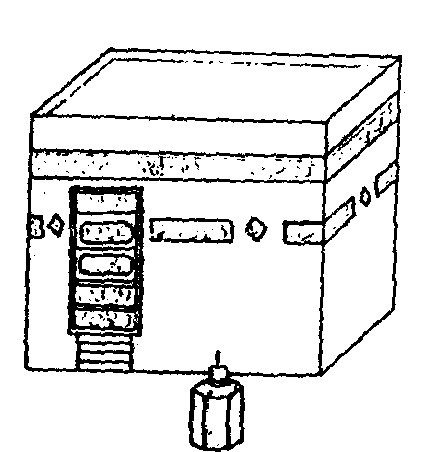
Namazi faces Qiblah (in Makkah)
He raises both hands upwards towards his head in such a manner that the palms of both hands face the Qiblah and the hands so raised reach to a height where the thumbs are in line with the lobes of the ears as shown in figure below:-
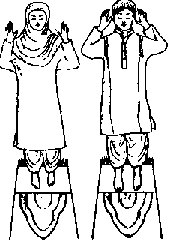
This sketch shows hands raised up to ears in case of male and up to shoulders in case of female
Once the hands reach the required height (the ear-lobes), the Namazi should immediately bring them down and fold them below the navel. When folding the hands Namazi should ensure that the right hand is on top of the left hand.
The right hand should grasp the left hand in such a manner that the thumb and little finger of the right hand encircle the left wrist. The other three fingers of the right hand are spread horizontally along the left forearm immediately above the wrist as shown in figure below:
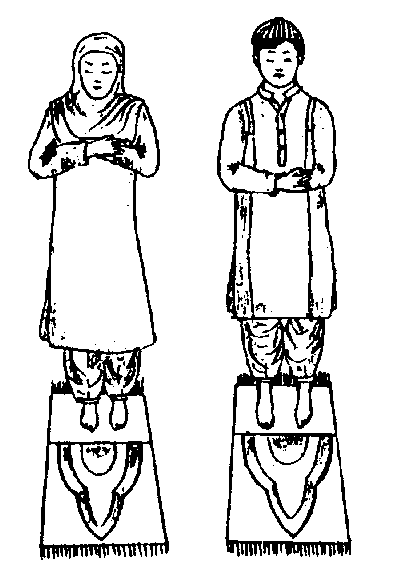
- Namazi facing Qiblah in position of Qiyaam.
- The female folds her hands across her chest as shown.
Once the hands have been folded as explained above, the Namazi should recite the following:
Sana

(Sub-hanna-kal-laa Hum-ma Wa Bi-hamdi-ka Wa Ta-baa-rakas-mu-ka Wa Ta-aala Jad-du-ka Wa Laa-ilaa-ha Ghay-ruk.)
Glory unto You, O Allah! All praise unto You. Blessed, is Your Name and most high is Your Majesty. There is none worthy of worship, but You.
Taou-Wuz
After reciting Sana the Namazi recites Taou-Wuz, i.e.

(A-oozu Bil-llahi Minash-shaitwaa-Nir Rajeem.)
I seek the protection of Allah from Satan, the accursed.
Tasmiah
After Taou-wuz recite Tasmiah, i.e.
![]()
(Bis-Millah-Hir Rahmanir-Raheem)
In the name of Allah, the Most Beneficent, the Most Merciful.
After Tasmiah recite Surah Fatiha, and thereafter recite a few verses of the Holy Qur’an:
Surah Fatiha
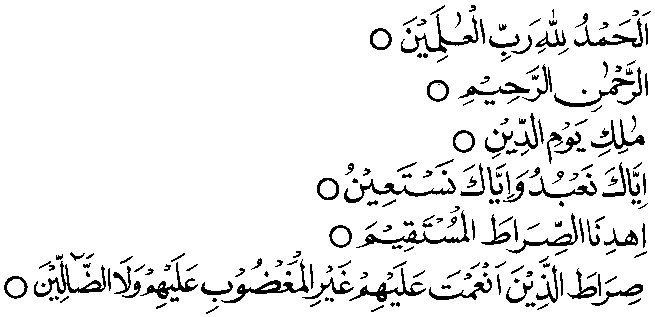
(Al-hamdo Lil-Lahi Rab-bil, Aa-lameen. Ar-rah-maanir-rahim. Maa-liki Yau-mid-deen. Iy-ya-ka Na-budu Wa-iy-ya-ka Nas-ta-een. Ih-dinas-siraatal Mus-ta-qeem. Siraa-tal-Lazeena An-amta Alai-him. Ghai-ril-Magh-dhoo-bi Alai-him Wa-lad-dhaal-leen Ameen).
Praise is to Allah, Lord of the worlds. The Beneficent, the Merciful: Owner of the Day of judgement. Thee (alone) we worship; Thee (alone) we ask for help; show us the straight path. The path of those whom Thou hast favoured. Not the (path) of those who earn Thine anger nor of those who go astray Ameen).
Tasmiah
This is known as Tasmiah.
![]()
(Bis-Millah-Hir Rahmanir-Raheem)
In the name of Allah, the Most Beneficent, the Most Merciful.
Surah Ikhlas
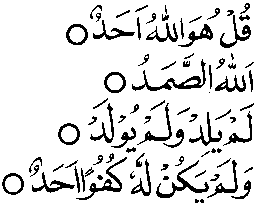
(Qul Huwal-la-hu Ahad Allahus-samad. Lam Yalid Wa-lum Yu-lad. Wa Lam Ya-kul-lahoo Kufu-wan Ahad.)
Say (O Prophet!): He is Allah. The One and Only Allah, the Eternal Absolute: He begetteth not, nor was He begotten: And there is none like unto Him.
Surah Falaq
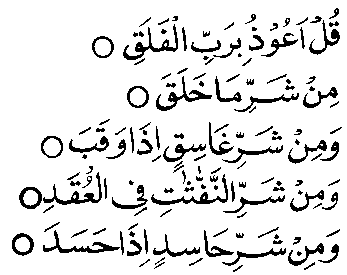
(Qul A-oozo Bi Rab-bil Falaq. Min Shar-ri Ma Khalaq. Wa-min Shar-ri Gha-si-qinn Iza Waqab. Wa-min Shar-rin-naf-fasati Fil-Uqud. Wa-min Shar-ri Ha-sidin Iza Hasad.)
Say (O Prophet!): I seek refuge with the Lord of the dawn: from the mischief of all creations, from the mischief of darkness as it over spreads, from the mischief of those women who practise secret arts breathed on knots. And from the mischief of the enviable one as he practises envy.
Surah Naas
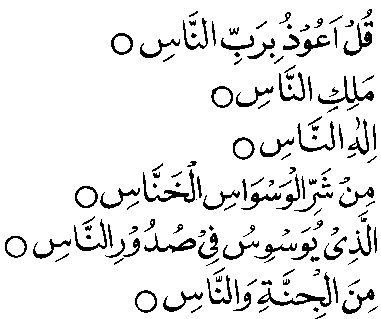
(Qul A-oo-zu Bi Rab-bin Nas. Ma-li-kin Nas. Ila-hin Nas. Min Shar-ril Was-wa-sil Khan-nas. Al-lazi Yu-was-wisu Fi Suddo-rin-nas. Mi-nal Jinnati-Wan-nas.)
Say (O Prophet!): I seek refuge with the Lord of the mankind, the King (or Ruler) of mankind, the Allah of mankind, from the mischief of the sneaking whisperer, who whispereth (evil) unto the breasts of mankind, whether of jinn or of mankind.
The posture of Qiyaam ends at this point, i.e. after completing the recital of a few verses of the Holy Qur’an. Surah Fatiha, together with a few other verses of the Holy Qur’an, are known as the Qiraat.)
At the end of Qiraat, the Namazi should utter:
![]()
(Allaho-Akbar)
<Allah is great
and go into Ruku or the posture known as genuflexion.
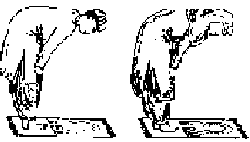
This sketch shows Namazi in Position of Ruku.
Ruku
In this posture the Namazi grasps both knees with his hands, the fingers being outspread. The head and back should be in line. The Namazi should not hump his back. The head should not drop, but be kept erect in line with the back.
The arms should be separated from the body without the elbows bulging out. The gaze should be fixed on one’s feet. In the position of Ruku, recite the following Tasbih:

(Sub-haa-na Rabbiyal-Azeem)
Oh! Glory unto my Creator, the Majestic
This Tasbih should be recited thrice, five or seven times.
After reciting the above Tasbih in Ruku, the Namazi should say:

(Sami-Allahu Liman Hamidah)
Allah hears him who praises Him
Qauma
This position of standing erect after the Ruku is called Qauma. The Qauma ends with the reciting of the Tahmeed.
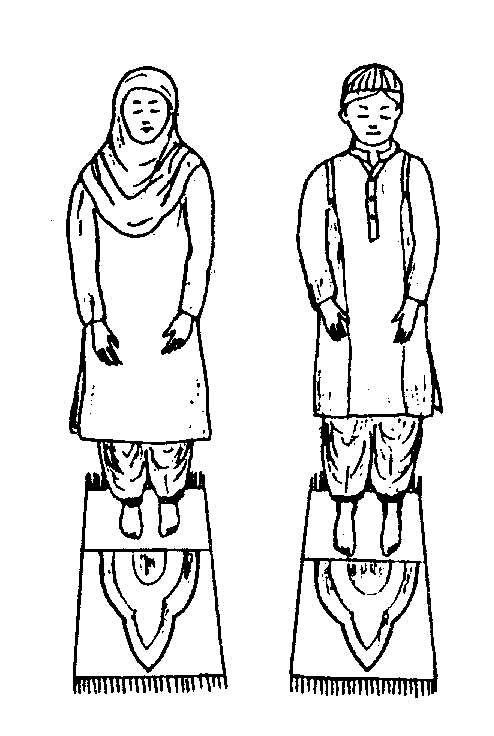
This sketch shows Namazi in Position of Qauma.
Tahmeed
As the Namazi rises out of Ruku and stands erect he recites the Tahmeed:

(Rab-banaa La-kal Hamd)
Oh our Creator! All Praise belongs unto you
Sajda
After reciting Tahmeed the Namazi utters Allaho Akbar and goes down into the posture of Sajda or Prostration. As the Namazi goes into Sajda he places on the ground firstly his knees, then both hands. The head is placed on the ground between the two hands. The fingers are held together facing the Qiblah, the thumbs being in line but a few inches away from the lobes of ears, as in Takbeer at start of the Salaat. As the head goes into Sajda the nose should firstly touch the ground and then the forehead. Both arms must be kept away from the sides of the body (not for women). Both feet should be planted firmly on the ground with the toes bent in the direction of the Qiblah. Thighs should not touch the body (for men). Thighs should touch the body (for women) refer to 5.4.

Namazi in Position of Sajda
In this posture or Sajda the Namazi recites three, five or seven times the following Tasbih:
![]()
(Subhana Rab-biyal A’laa)
Glory unto my Creator, The Most High
After reciting this Tasbih, he raises first his forehead, then his nose, and finally his hands. He then goes into the kneeling posture, known as the jalsah, i.e. the posture that separates or intersperses two Sajdas. As he raises his head from the Sajda he utters:
![]()
(Allaho-Akbar)
Allah is great
and enters the jalsah.
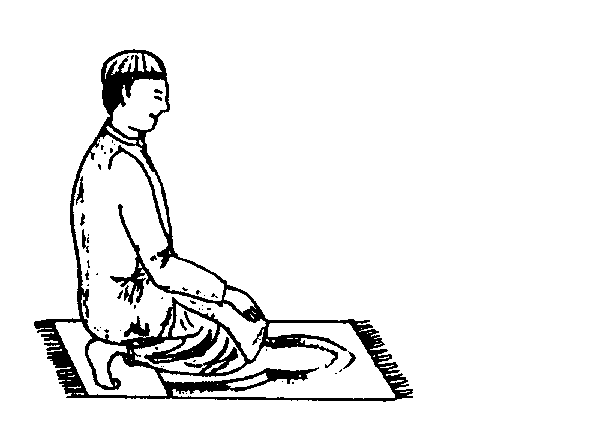
This sketch shows Namazi sitting in Jalsah in between Sajood
When sitting in Jalsah the left foot is spread out horizontally on the ground, the Namazi resting on it. The right foot is placed on the ground in a perpendicular (standing up) position with the toes facing the Qiblah. The hands are placed on the thighs with the fingers held together facing the Qiblah very close to the knees, but not pointing downwards.
Thereafter, he utters:
![]()
(Allaho-Akbar)
Allah is great
Then he goes into the second Sajda, which is exactly the same in performance as the first Sajda.

Namazi in Position of Sajda
The end of the second Sajda heralds the end of First Raka’at.
After completing the Second Sajda of the First Raka’at the Namazi says.
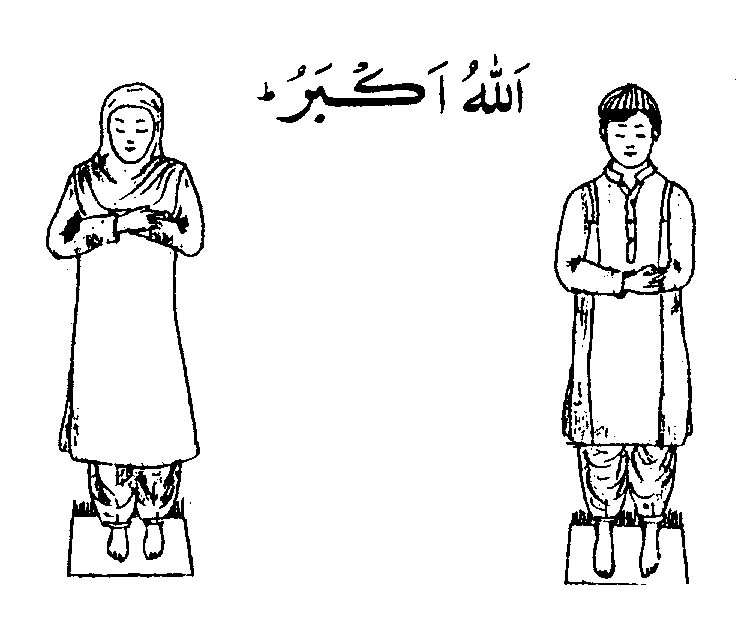
Namazi facing Qiblah in position of Qiyaam. The female folds her hands across her chest
and enters the Qiyaam posture of the Second Raka’at, i.e. he once again stands erect, folding his hands on top of each other as explained previously.
During the Second Raka’at the following things will not be carried out as was the case in the first Raka’at.
- The hands will not be raised to the ears.
- Sana will not be recited.
- Taou-wuz will not be recited.
Further the entire Second Raka’at will be performed in exactly the same manner as the First Raka’at with the three aforementioned exceptions.
The Qad’ah
Once the Second Sajda of the Second Raka’at is completed, the Namazi utters:
![]()
(Allaho-Akbar)
Allah is great
and sits in the kneeling position, i.e. the exact position he assumed in the Jalsah.
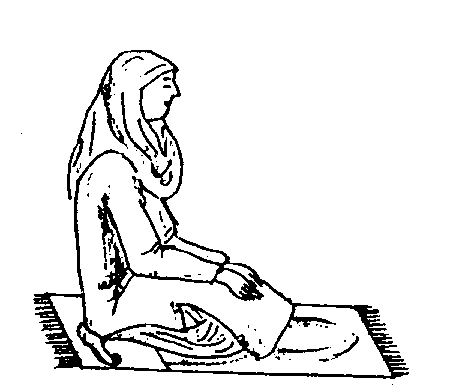
Namazi sitting in Qad’ah Position and reciting Tashah-Hud
Sitting position of the Second Raka’at is termed Qad’ah. (The kneeling posture between Sajdas is called Jalsah.)
During the Qad’ah the Namazi recites Tashah-hud as follows:

(At-tahiy-yatu Lil-laahi Was Sala-waatu Wat-tay-yibatu Assalamu Alaika Ay-yuhan Nabiy-yu Warah-matul-lahi Wabarakatuh. Assalaamu Alaina Wa-ala Ibadil-lahis-saaliheen. Ash-hadu-al Laa-ila-ha Il-lal-lahu Wa-ash-hadu Anna Muhammadan Ab-duhu Wa Rasooluh.)
All our oral, physical and monetary Salaats are only for Allah. Salvation to you Oh Prophet! And Allah’s peace and His blessings be on you. Blessings of Allah be on us and on all those worshippers who are pious. I testify that there is none to be worshipped but Allah and I testify that Muhammad is His worshipper and Messenger.
If the Salaat, which is being performed is a Two Raka’at Salaat, Durood and Dua should also be recited after the Tashah-hud.
Durood
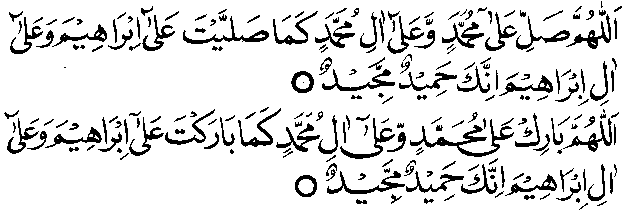
Allahumma Swalli Ala Muhammadin Wa-ala Aali Muhammadin Kama Swal-laita Ala Ibrahima Wa-ala Aali Ibrahima In-naka Hamidum-Majeed
Allahumma Barik ala Muhammadin Wa-ala Aali Muhammadin Kama Barak-ta Ala Ibrahima Wa Ala Aali Ibrahima In-naka Hamidum-Majeed.
Oh Allah! Shower Thy mercy on Muhammad and on his seeds as Thou hast sent Thy mercy on Ibrahim and his seeds. No doubt! Thou art Great and Praiseworthy! Oh Allah! Send Thy blessings on Muhammad and on his seeds as Thou hast blessed Ibrahim and his seeds. No doubt! Thou art Great and Praiseworthy.
Dua

(Rabbi J’alni Muqim As-salati Wa mindhurriyyati Rabbana Wa-taqabbal du’a. Rabba-naghfirli Wali-walidayya Walil-mu’mineena Yauma Yaqum-ul-hisab.)
O my Lord! Make me one who establishes regular Salaat, And also (raise such) Among my offspring O our Lord! And accept thou my Salaat.
O our Lord! Cover (us) with thy Forgiveness - me, my parents, and (all) Believers, on the day that the Reckoning will be established!
Salaam
After the Dua the Namazi terminates his Salaat by offering what is called Salaam. Salaam is made by addressing the angel on each shoulder and saying:

(Assalaa-mu-alaikum Wa Rah-matul-lah.)
Peace upon you and the Mercy of Allah.
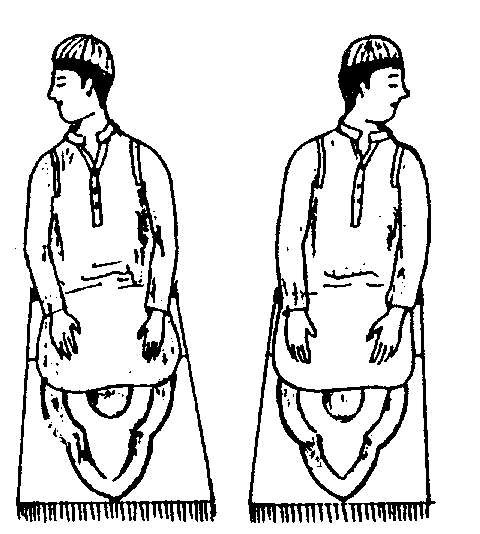
Namazi sitting in Qad’ah position and turning face to the right and left and reciting Salaam.
and simultaneously turning the head towards the right-side focusing gaze on the right shoulder. The above Salaam is then recited a second time turning the face to the left side with the gaze fixed on the left shoulder this time.
Your Salaat has now been completed.
- If the Salaat which is being performed is a Three Raka’at Salaat, the Namazi, after reciting only Tashah-hud (at the end of the second Raka’at) enters the Third Raka’at by rising once again assuming the Qiyaam posture. The Third Raka’at is performed in exactly the same manner as the second Raka’at. However, if the Salaat is a Fardh Salaat then in the Third and Fourth Raka’at only Surah Fatiha is recited. Other verses of the Holy Qur’an are not added as was done in the First and Second Raka’at.
After the second Sajda of the Third Raka’at has been completed, the Namazi again assumes the posture of Qad’ah. In this final Qad’ah Tashah-hud. Durood and Dua are recited. After the Dua making the two Salaams as already explained completes the Salaat.
- If the Salaat is a Four-Raka’at Salaat, the Namazi does not assume the Qad’ah posture at the end of the Third Raka’at, but goes immediately into the Qiyaam of the Fourth Raka’at. It is only after the second Sajda of the Fourth Raka’at that the Namazi sits in Qad’ah. In this Qad’ah, the Namazi recites Tashah-hud, Durood and Dua. He then ends the Salaat by making both Salaams.
The Description of Witr Salaat
To perform the Witr Salaat is compulsory. The first and second Raka’at of the Witr Salaat is performed in the same manner as the first and second Raka’at of a Fardh Salaat. But in the 3rd Raka’at of the Witr, after reciting Surah Fatiha and a Surah or some verses of the Qur’an, the Namazi utters:
![]()
(Allaho-Akbar)
Allah is great
and simultaneously raises both hand to the ears (as is done at the beginning of Salaat). Thereafter he folds both hands in the usual manner just below the navel. The Namazi now recites Dua-e-Qunoot, and after the Qunoot he goes into Ruku and completes the Salaat in the normal manner.
Dua-e-Qunoot
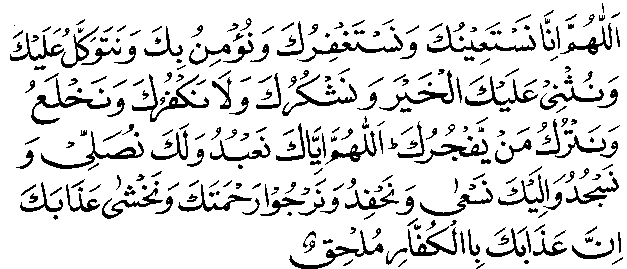
(Allahumma Inna Nasta-ee-Nuka Wa Nas-tagh-firuka Wa Numinu Bika Wa Na-tawak-kalu Alaika Wa Nus-ni Alaikal Khair Wa Nash-kuruka Wala Nak-furuka Wa Nakh-la-u Wa Nat-ruku Maiy-yaf Juruka Allahumma Iy-yaka Na’budu Walaka Nusalli Wa Nasjudu Wa Ilaika Nas-a Wa Nah-fidu Wa Nar-joo Rahmataka Wa Nakh-sha Azabaka Inna Azabaka Bil Kuffari Mulhiq.)
Oh Allah! We beseech Thy help and ask Thy pardon and believe in Thee and trust in Thee, and we praise Thee in the best manner and we thank Thee and we are not ungrateful to Thee, and we cast off and leave one who disobeys Thee. Oh Allah! Thee alone do we serve and to Thee do we pray and prostrate and to Thee do we flee and we are quick in doing so and hope for Thy blessings, and fear Thy chastisement. No doubt Thy chastisement overtakes the unbelievers.
A woman performs Salaat in the same manner as a man does. However, there are certain differences, which are enumerated hereunder:
- In the beginning of the First Raka’at, during the Takbeer Tahreemah, a woman does not raise her hands to the ears. She raises them only to shoulder-level and keeps them concealed in her head cover.
- When folding the hands, a woman places both palms on the chest - the right palm on top of the left palm.
- The Ruku of a female is a slight bow, with the tips of the fingers just touching the knees. The arms should be placed together with the sides of the body, and both ankles should touch each other.
- In Sajda, her feet will not be kept erect, but will be placed horizontally on the ground, pointing towards the right. She must not separate her arms from her body as a man does. She should draw her body inwards as much as possible, the stomach touching the thighs.
- In Jalsah and Qad’ah as well, she rests her posterior on the ground (instead of on her leg as is the case with a man) with both her feet spread out on her right side horizontally on the ground.
- In certain Salaat a man can recite the Qiraat loudly but it is not permissible for a female to recite the Qiraat loudly.
Speech
- Speaking, whether intentionally or unintentionally, nullifies Salaat. Even the uttering of a word such as ‘ah’ or ‘oh’ will break one’s Salaat.
- In unnecessarily clearing one’s throat, if a sound is emitted, the Salaat breaks. However, should it become necessary to clear the throat, the Salaat will then not be nullified in this case.
- If one, by force of habit, uttered:
![]()
(Al-hamdo Lillah)
All praise is for Allah
While sneezing in Salaat, the Salaat does not break. However, one should not say Alhamdu Lilla, when sneezing during Salaat.
- During Salaat to reply to someone greeting you breaks Salaat.
Action
- If an action, which does not form part of Salaat, is done during Salaat, the Salaat is nullified. For example, to recite the Qiraat looking inside the Qur’an; to button one’s shirt: to walk: to eat; to drink.
- If during Salaat one’s chest is turned away from the Qiblah, the Salaat breaks.
- Laughing aloud during Salaat nullifies the Salaat.
Acts Forbidden and Reprehensible during Salaat
Certain acts during Salaat are Makruh Tehrimi. If the Namazi commits these acts, his Salaat is not nullified but the Reward of the Salaat is reduced and he sins in doing them. These Makrooh Tehrimi acts are:
- To fiddle with one’s clothing, beard and hair.
- To crack one’s fingers.
To glance to the right or left.
- To sit in Qad’ah or Jalsah in a way other than described in the section dealing with the method of Salaat.
- To place the hands on the hips.
- To perform Salaat facing another direction than Qiblah.
- To perform Salaat on a carpet or cloth with pictures of people or animals on them.
- To perform Salaat wearing cloths with pictures on them.
- To lengthen considerably the second Raka’at more than the first Raka’at.
- To fix a particular Surah for a Salaat.
- To place the head during Sajda on a higher level than the place whereon the feet are resting. If the spot on which the head is placed is higher than one span (23cm), the Salaat is not valid. If the spot is less than a span, the Salaat is valid, but to do so unnecessarily is Makruh.
Acts which justify Breaking of Salaat
- The Namazi may break his Salaat in order to avoid any loss, harm or injury to life or property, no matter if the property involved is of little value.
- It is Fardh to break one’s Salaat in order to save life or prevent injury to people.